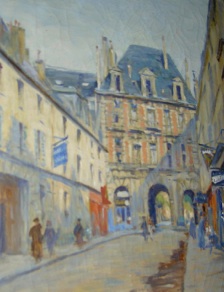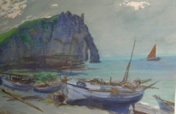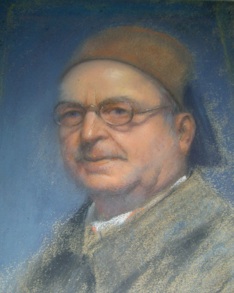André Eugène COSTILHES (1865-1940)






His life is that of a young man from Cunlhat (a village in Auvergne) who starts working as a plaster and paint worker like his father and who, thanks to his remarkable gifts for drawing, his tenacity and to the support of the mayor of his village, Mr Edmond Guyot-Dessaigne, "goes up "to Paris when he is 18 years old. He passes the exam of Fine Arts and becomes, at the beginning of the century, a drawing teacher and painter, a decorator too, in the capital city.
He draws and paints the most varied subjects (portraits, nudes, monuments, landscapes, still lives) with various techniques which he all masters (oil paintings, watercolours, gouache, pastels, charcoal and red chalk drawings). He exhibits works of art in the main Salons (French Artists, Independents, Autumn...) as soon as 1891. Some of his works of art are bought by the State for museums, among which we find the Louvre and the Museum of Art of Clermont-Ferrand.
1865-1882: childhood and Adolescence in Cunlhat
AEC was born on April the 8th 1865 in Cunlhat, in an extremely humble family coming from Auvergne. After his schooling in Cunlhat, he works as an apprentice painter with his father. In 1881,when he is 16, he goes to Clermont-Ferrand where he works as a painter for six months. He then returns to Cunlhat where he is both a plaster painter and a self-made art painter.
1883-1892: training in Paris
In 1883, at the age of 18, he goes to Paris thanks to the support of the mayor Guyot-Dessaigne, who will become his friend. In the capital city, he takes both drawing lessons for adults in the 14th district of Paris and evening lessons at the Superior National School of Decorative Art in 1883 and 1884. He is Eugene Grasset's pupil (one of the forerunners of Art Nouveau) with whom he will collaborate from then on. He gets the best marks in the competitive exam of the National Superior School of Fine Arts where he becomes the pupil of Luc Olivier-Merson, Pierre-Victor Galand and particularly Léon Bonnat. He gets 26 rewards and passes, as these years go by, the different competitive exams that punctuate the Schooling of Fine Arts. He becomes a teacher with a cabinet decree. He then goes to Marseille where he teaches drawing in a secondary school for one year.
1893-1913: the Jeanne Lafont years
In 1893, André Eugene marries Jeanne Lafont in Clermont-Ferrand. The same year, he falls ill and goes on sick leave for the three following years. He dwells in Clermont-Ferrand during these years, taking his easel in the neighbouring villages. He exhibits works of art in the local Salons: thus, in 1895, at the exhibition of the Fine Arts in Clermont-Ferrand. That same year, he is asked to make decorative paintings for the Clermont-Ferrand prefecture. During his official visit, President Felix Faure "admires, in the prefecture hall, the panels painted by Mr Costilhes and Mr Chassagne. He declares that he will order two panels for the Elysée Palace (the President's official residence). The same evening, he meets both artists". Another echo from the local press says that "the walls of the hall are hung with Mr Costilhes and Mr Chassagne's beautiful decorative paintings of the most gracious effect, these two artists being former scholarship holders of the Auvergne Department at the Fine Arts National School".
André Eugene goes to Paris from time to time but regularly to Cunlhat where he henceforth mixes with the notables of the village and goes to their meetings. He moves to Paris for good with Jeanne in 1896; she has become his pupil, but she paints in paler tonalities. She signs Jane Costilhes and exhibits her paintings, in particular at the Salon of the Independents in 1911 and 1912. In 1913, she dies as a result of an operation at the age of 39. Totally distraught and worn out because of this sudden death, André Eugene ceases to draw and paint for a long time. His faithful friend Henri Laugier helps him to resurface. But he will cease to exhibit his works of art almost completely although he has reached the fullness of his art during this part of his life, that is to say during 25 years. Before the 1914/1918 war, his landscapes mainly represent Auvergne, Brittany, Paris and its surroundings. After the war, still Auvergne and Paris, but also Normandy and the outskirts of Paris, particularly Pontchartrain.
1914-1940: the Anna Fontaine years
Eager to have children, he gets married again in 1915 with Anna Fontaine, a nurse and social worker. Three children are born from this marriage. Since his father's death in 1920, and growing old, he rarely goes to Clermont-Ferrand and to Cunlhat and he soon stops going there. Another tragedy strikes André Eugene in 1929: his younger daughter dies from typhoid fever at the age of 5. He retires in 1930, and his teacher's small pension is hardly enough to provide for his family, his two other children being students. He will go on drawing and painting until the extreme limit of his life. He goes around the districts of Paris with his painting set, and does customers' portraits in his Birague Street Studio. He also draws and paints many portraits of the members of his family, and a few self-portraits. In June 1940,separated from his wife because she has been transferred to the South-west of France, he goes on exodus to Clermont-Ferrand with his daughter Berthe and two friends. He goes on drawing during these few days in Auvergne. But he is physically and morally worn down, very affected by the defeat, and he goes back to Pontchartrain a week later. He dies on September the first 1940, without having seen his wife again, who will be able to get back to the Paris region only three weeks later. His ashes lie in the graveyard of Jouars-Pontchartrain.
A decorative painter
As a member of the Society of the decorative-painter Artists and later of the Union of the Decorative Arts, as a member of the friendly Society of the French Painters and Sculptors, André Eugene devotes a big lapse of his time to decorative painting. In 1899,he contributes with the members of the Artistic Society of the Illustrated Book to the wood engraving of Gérardin's original compositions adorning Paul Verlaine's book "The Gallant Feasts". With Eugene Grasset, he participates in works of decoration for the 1900 Universal Exhibition. He also decorates private hotels, public institutions, castles and churches, and draws wrought iron railings for wrought iron craftsmen. Close to Eugene Grasset, he is interested in the Nancy School, forerunner of Art Nouveau. From 1916 to 1930, he teaches at the Arago School and he is also the Head of the Superior Course of evening classes for adults, 6 Place des Vosges in Paris. He devotes himself to the living model section (academic nudes). He is also keen on photography: he achieves hundreds of glass plates, a part of which representing Auvergne being at the picture library of the Puy-de-Dôme regional archives in Clermont-Ferrand. Some of his works of art are used, and sometimes drawn or painted, for adverts. In 1902,he becomes both an Academy Officer and Public Instruction Officer.
A humanist artist
André Eugene frequently sees Academics and Scientists, such as his close friend Henri Laugier (who will be, among other high profile jobs, assistant secretary general at the UN after the war and who will help to write the Universal Declaration of Human Rights), and men who have the social streak like him. Painters such as Victor Charreton and Pierre Franc-Lamy are also his friends. In the Thirties, he is a member of the "Montparnasse Pack", an intellectual and mutual aid artistic group among whom a few artist members dwell at the famous "Art Hive", at the Danzig Passage in the 15th district of Paris. He also keeps in touch with the Auvergne natives in Paris, particularly by means of the Society of the Cabbage Soup of which he is a regular member, and which organizes an Art Salon of Auvergne every year from 1885 to 1914. As a Republican, a Progressist, a Pacifist and a Freethinker, he does not hesitate to get involved. In 1899, he is a member of the Workers' Society of General Painting. In 1902,he becomes an active-founder member of the Farsighted People, a civil and philanthropic society set in Paris. Initiated in Cunlhat by Guyot-Dessaigne when he is still young, he subscribes to Freemasonry around 1902, to the Free Thought of the Great Orient of France Lodge. But André Eugene ceases to be a member of the Lodge about ten years later. He is a member of the French Artists Society, together with the Independent Artists Society whose Salon will set on its cyma all the history of modern painting.
traduction : Jacqueline Costilhes, épouse Coquelet